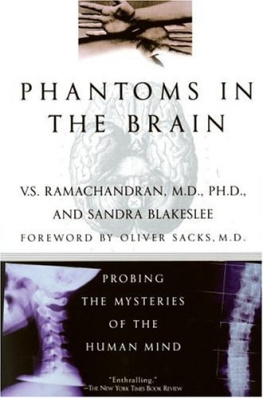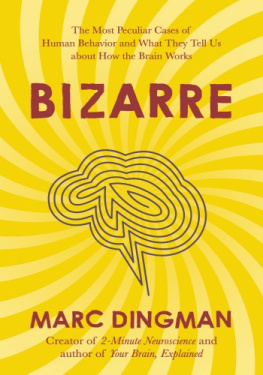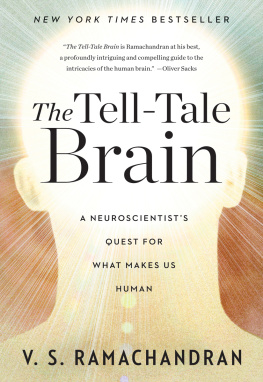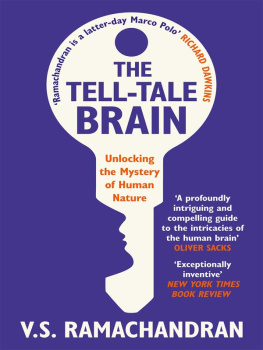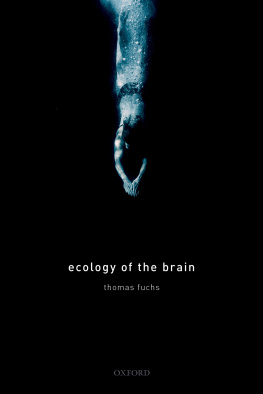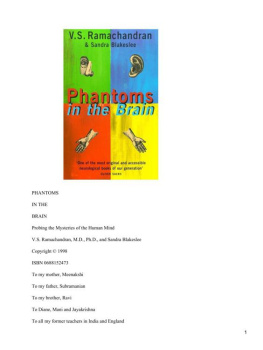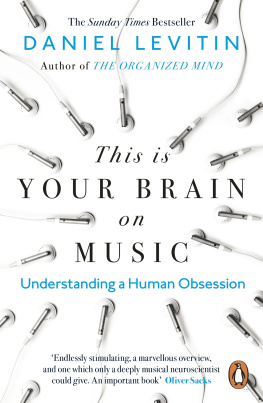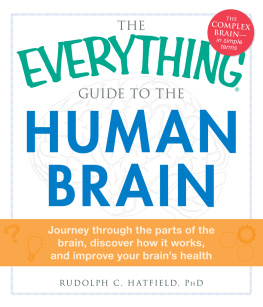
PHANTOMS
IN THE
BRAIN
Probing the Mysteries of the Human Mind
V.S. Ramachandran, M.D., Ph.D., and Sandra Blakeslee
Copyright 1998
ISBN 0688152473
To my mother, Meenakshi
To my father, Subramanian
To my brother, Ravi
To Diane, Mani and Jayakrishna
To all my former teachers in India and England
To Saraswathy, the goddess of learning, music and wisdom
Foreword
The great neurologists and psychiatrists of the nineteenth and early twentieth centuries were masters of description, and some of their case histories provided an almost novelistic richness of detail. Silas Weir Mitchellwho was a novelist as well as a neurologistprovided unforgettable descriptions of the phantom limbs (or "sensory ghosts," as he first called them) in soldiers who had been injured on the battlefields of the Civil War. Joseph Babinski, the great French neurologist, described an even more extraordinary syndromeanosognosia, the inability to perceive that one side of one's own body is paralyzed and the oftenbizarre attribution of the paralyzed side to another person. (Such a patient might say of his or her own left side, "It's my brother's" or "It's yours.") Dr. V.S. Ramachandran, one of the most interesting neuroscientists of our time, has done seminal work on the nature and treatment of phantom limbsthose obdurate and sometimes tormenting ghosts of arms and legs lost years or decades before but not forgotten by the brain. A phantom may at first feel like a normal limb, a part of the normal body image; but, cut off from normal sensation or action, it may assume a pathological character, becoming intrusive, "paralyzed," deformed, or excruciatingly painfulphantom fingers may dig into a phantom palm with an unspeakable, unstoppable intensity. The fact that the pain and the phantom are
"unreal" is of no help, and may indeed make them more difficult to treat, for one may be unable to unclench the seemingly paralyzed phantom. In an attempt to alleviate such phantoms, physicians and their patients have been driven to extreme and desperate measures: making the amputation stump shorter and shorter, cutting pain or sensory tracts in the spinal cord, destroying pain centers in the brain itself. But all too frequently, none of these work; the phantom, and the phantom pain, almost invariably return.
To these seemingly intractable problems, Ramachandran brings a fresh and different approach, which stems from his inquiries as to what phantoms are, and how and where they are generated in the nervous system. It has been classically considered that representations in the brain, including those of body image and phantoms, are fixed. But Ramachandran (and now others) has shown that striking reorganizations in body image occur very rapidlywithin fortyeight hours, and possibly much less following the amputation of a limb.
Phantoms, in his view, are
generated by such reorganizations of body image in the sensory cortex and may then be maintained by what he terms a "learned" paralysis. But if there are such rapid changes underlying the genesis of a phantom, if there is such plasticity in the cortex, can the process be reversed? Can the brain be tricked into unlearning a phantom?
By using an ingenious "virtual reality" device, a simple box with a transposing mirror, Ramachandran has found that a patient may be helped by merely being given the sight of a normal limbthe patient's own normal right arm, for example, now seen on the left side of the body, in place of the phantom. The result of this may be instantaneous and magical: The normal look of the arm competes with the feel of the phantom.
The first effect of this is that a deformed phantom may straighten out, a paralyzed phantom may move; eventually, there may be no more phantom at all. Ramachandran speaks here, with characteristic humor, of
"the first successful amputation of a phantom limb," and of how, if the phantom is extinguished, its pain must also gofor if there is nothing to embody it, then it can no longer survive. (Mrs. Gradgrind, in Hard Times, asked if she had a pain, replied, "There is a pain somewhere in the room, but I cannot be sure that I have got it." But this was her confusion, or Dickens's joke, for one cannot have a pain except in oneself.) Can equally simple "tricks" assist patients with anosognosia, patients who cannot recognize one of their sides as their own? Here too, Ramachandran finds, mirrors may be of great use in enabling such patients to reclaim the previously denied side as their own; though in other patients, the loss of "leftness," the bisection of one's 2
body and world, is so profound that mirrors may induce an even deeper, throughthelookingglass confusion, a groping to see if there is not someone lurking "behind" or "in" the mirror. (Ramachandran is the first to describe this "mirror agnosia.") It is a measure not only of Ramachandran's tenacity of mind but of his delicate and supportive relationship with patients that he has been able to pursue these syndromes to their depths.
The deeply strange business of mirror agnosia, and that of misattributing one's own limbs to others, are often dismissed by physicians as irrational. But these problems are also considered carefully by Ramachandran, who sees them not as groundless or crazy, but as emergency defense measures constructed by the unconscious to deal with sudden overwhelming bewilderments about one's body and the space around it. They are, he feels, quite normal defense mechanisms (denial, repression, projection, confabulation, and so on) such as Freud delineated as uni
versai strategies of the unconscious when forced to accommodate the intolerable or unintelligible. Such an understanding removes such patients from the realm of the mad or freakish and restores them to the realm of discourse and reasonalbeit the discourse and reason of the unconscious.
Another syndrome of misidentification that Ramachandran considers is Capgras' syndrome, where the patient sees familiar and loved figures as impostors. Here too, he is able to delineate a clear neurological basis for the syndromethe removal of the usual and crucial affective cues to recognition, coupled with a not unnatural interpretation of the now affectless perceptions ("He can't be my father, because I feel nothinghe must be a sort of simulacrum").
Dr. Ramachandran has countless other interests too: in the nature of religious experience and the remarkable
"mystical" syndromes associated with dysfunction in the temporal lobes, in the neurology of laughter and tickling, anda vast realmin the neurology of suggestion and placebos. Like the perceptual psychologist Richard Gregory (with whom he has published fascinating work on a range of subjects, from the fillingin of the blind spot to visual illusions and protective colorations), Ramachandran has a flair for seeing what is fundamentally important and is prepared to turn his hand, his freshness, his inventiveness, to almost anything.
All of these subjects, in his hands, become windows into the way our nervous systems, our worlds, and our very selves are constituted, so that his work becomes, as he likes to say, a form of "experimental epistemology." He is, in this way, a natural philosopher in the eighteenthcentury sense, though with all the knowledge and knowhow of the late twentieth century behind him.
In his Preface, Ramachandran tells us of the nineteenthcentury science books he especially enjoyed as a boy: Michael Faraday's Chemical History of a Candle, works by Charles Darwin, Humphry Davy and Thomas Huxley. There was no distinction at this time between academic and popular writing, but rather the notion that one could be deep and serious but completely accessible, all at once. Later, Ramachandran tells us, he enjoyed the books of George Gamow, Lewis Thomas, Peter Medawar, and then Carl Sagan and Stephen Jay Gould.
Next page
